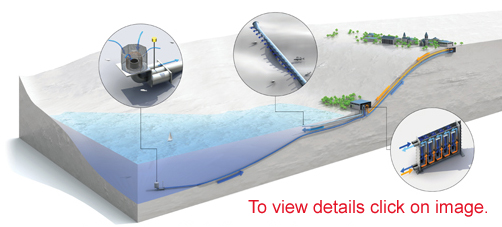Yes, In My Backyard
DISTRICT ENERGY
Decentralizing the heating and cooling of buildings has been the preoccupation of the International District Energy Association (IDEA) for about a century. District energy, according to IDEA, is a system that produces steam, hot water, or chilled water at a central plant and pipes it out to buildings in the district for space heating, domestic hot water heating, or air conditioning. Individual buildings don't need their own boilers or chillers. Such systems have long been popular on university campuses; they are also found on military bases, at airports, and in office parks. Central physical plants may be most obviously practical in situations where one owner controls a group of buildings, but some district energy systems are run by municipal utilities in urban centers. One of the oldest and largest is Consolidated Edison, which serves steam to 1,800 buildings in Manhattan. Steam-driven cooling reduces peak demand for electricity and eases demand on the local power grid. District energy reduces the cost of HVAC equipment and equipment rooms in buildings, and frees rooftops for other functions.
LAKE-SOURCE COOLING Cornell University, Ithaca, New York |
 |
Cold water deep in Cayuga Lake provides cooling for the Cornell campus. The system has two separate water circulation loops. The first pumps 40-degree water from the lake floor to a heat- exchange building. Water chilled to 43 degrees then travels in a closed loop three miles uphill and circulates to cool the campus buildings, saving 25 million kWh per year. Illustration by Bryan Christie Design |
Â
One big advantage of district energy systems is that, because they are much larger than the physical plant of a single building, they can support combined heat and power (CHP), also known as cogeneration. CHP increases the efficiency of a power plant because the highest-grade energy generates electricity, and lower-grade, "waste" heat is still usable to heat or cool buildings. When remote power plants generate electricity, the lower-grade heat is literally wasted. IDEA estimates cogeneration doubles the efficiency of any fuel.
IDEA President Robert Thornton is skeptical of the emphasis on the national grid by federal policymakers. He says: "Building transmission systems to support large renewable assets outside the business district or population centers strike me as not the wisest use of capital in all cases. I'm more in favor of community-scaled distribution." He also believes heating and cooling of buildings-responsible for 40 percent of U.S. energy use-is "better done with fluids than with wires." Of course there are transmission losses in district systems, but they are not as great as those from high-voltage transmission lines across vast distances. Con Edison's well-insulated steam lines lose 3-12 percent of their energy within Manhattan. In general, Thornton says, you need about 10,000 tons of cooling load within about a half-mile radius for optimum efficiency. The number varies for heating, but IDEA offers computer tools for calculating optimization depending on project location and other factors. The organization is working with the U.S. Green Building Council to formalize credits for district energy in the LEED rating system. A building can receive Energy and Atmosphere credits if the district energy system that serves it meets certain efficiency standards.
The potential for savings are vast. Worldwide, Thornton says, about two-thirds of the fuel used to make electricity is lost as unused heat. "Fifty thousand gigajoules of energy goes into the global electric grid, and only 16,000 comes out as useful electricity." Recouping that loss would make a huge impact on global energy consumption. The concept becomes still more compelling when the fuel source is renewable.









